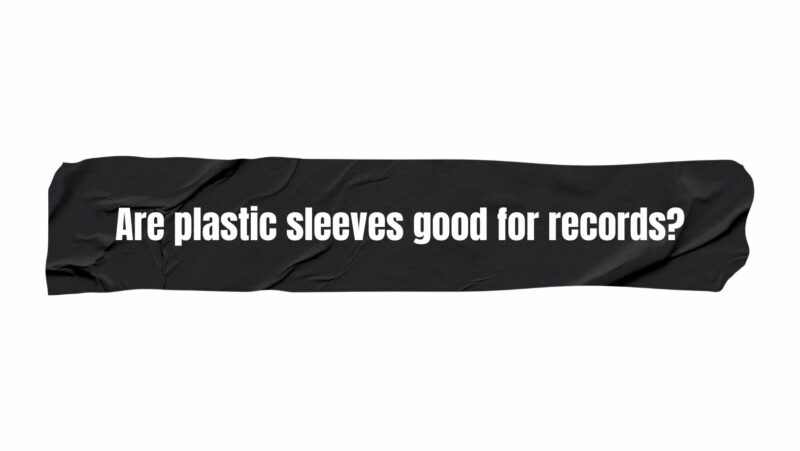Vinyl records hold a special place in the hearts of music enthusiasts, collectors, and audiophiles. These analog treasures not only offer a unique sonic experience but also serve as gateways to the past, showcasing album art, historical context, and artistic expression. In the realm of vinyl preservation, plastic sleeves have emerged as indispensable accessories. The question of whether plastic sleeves are good for records is a pertinent one, as it delves into the protective role these sleeves play in safeguarding the integrity, longevity, and value of vinyl records. In this comprehensive guide, we will delve into the multitude of benefits that plastic sleeves offer for vinyl records, examining their impact on protection against wear, dust, and contaminants, preservation of artwork, enhancement of collectibility, and the role they play in nurturing a lasting connection to the world of vinyl.
1. Protection Against Wear and Tear
Plastic sleeves are a formidable defense against the inevitable wear and tear that vinyl records encounter over time:
- Shielding from Dust and Contaminants: The primary function of plastic sleeves is to act as a barrier against dust, dirt, and contaminants that can accumulate on the record’s surface. By preventing these particles from settling on the vinyl, sleeves significantly reduce the risk of scratches, scuffs, and damage during handling and playback.
- Minimizing Surface Abrasion: The act of sliding records in and out of their original cardboard jackets can lead to friction and abrasion that compromises the vinyl’s surface. Plastic sleeves serve as a protective buffer, reducing the friction and minimizing the risk of surface abrasion.
2. Safeguarding Artwork and Album Covers
Vinyl records are not only about sound; they are also about visual artistry, storytelling, and cultural significance. Plastic sleeves play a crucial role in preserving the aesthetic and historical value of album covers:
- Preserving Visual Integrity: Album covers are a visual representation of the music and its era. Plastic sleeves shield album covers from fading, creasing, and damage caused by exposure to light, dust, and environmental factors, ensuring that their visual integrity remains intact.
- Cultural and Historical Significance: Album covers provide valuable insights into the cultural and historical context of the music. By protecting these covers, plastic sleeves contribute to preserving the cultural and artistic significance associated with each record.
3. Prevention of Deterioration
Vinyl records are vulnerable to deterioration caused by various environmental factors, and plastic sleeves provide a protective shield against these issues:
- Moisture and Humidity: Exposure to moisture and humidity can lead to warping, mold growth, and deterioration of the record’s surface. Plastic sleeves create a barrier that prevents moisture from reaching the record, safeguarding it from these potential hazards.
- Temperature Fluctuations: Rapid temperature changes can result in the expansion and contraction of records, leading to warping and degradation. Plastic sleeves help moderate temperature shifts, minimizing the stress placed on the vinyl.
4. Enhancement of Value and Collectibility
For collectors, the condition of a vinyl record significantly influences its value and collectibility. Plastic sleeves play a pivotal role in maintaining the condition of records:
- Preserving Mint Condition: Plastic sleeves contribute to maintaining the “mint” condition of records by preventing signs of wear, such as scratches, scuffs, and ring wear, which can downgrade the grade of a record.
- Collectible Value: In the realm of rare and collectible records, the presence of a well-maintained original plastic sleeve can enhance the record’s value. Collectors often prioritize records with intact sleeves due to their association with care and attention to preservation.
5. Types of Plastic Sleeves
There are various types of plastic sleeves available, each with its own benefits and purposes:
- Standard Plastic Sleeves: These sleeves offer basic protection against dust, dirt, and wear. They are a cost-effective option and suitable for everyday use.
- Anti-Static Sleeves: Anti-static sleeves are designed to minimize static electricity, which can attract dust particles. These sleeves are particularly beneficial for preventing static buildup on the record’s surface.
- Archival-Quality Sleeves: Archival-quality sleeves are made from materials that are free from acids and PVC. These sleeves are ideal for long-term preservation, as they prevent chemical reactions that could damage the record over time.
6. Choosing the Right Plastic Sleeves
Selecting the right plastic sleeves is essential to ensure optimal preservation and protection:
- Material Quality: Choose sleeves made from high-quality, archival-safe materials that are free from acids, PVC, and other harmful components. These materials prevent chemical reactions that can damage records over time.
- Size and Fit: Ensure that the sleeves are the appropriate size for your records. Sleeves that are too loose or too tight can lead to problems during insertion and retrieval.
Conclusion
The question of whether plastic sleeves are good for records is resoundingly answered through their multifaceted benefits. These sleeves are not merely accessories; they are guardians of musical history, protectors of visual artistry, and enhancers of collectibility. By shielding records from wear, protecting album covers, preventing deterioration, and enhancing their overall value, plastic sleeves play a pivotal role in preserving the magic of vinyl records.
As you envelop your records in the protective embrace of plastic sleeves, you are contributing to the preservation of culture, history, and artistry. Each time you handle a record sheathed in its protective sleeve, you’re engaging with a piece of the past, a portal to the present, and an investment in the future. Ultimately, the synergy between plastic sleeves and vinyl records is a testament to the enduring love and dedication of those who cherish the tactile beauty of analog music.

